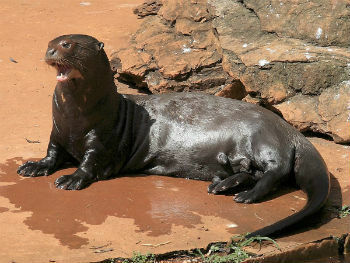Biology is a very broad science and, therefore, with a lot of subjects that can be charged in proof. However, despite the variety of themes, some are little explored and others extremely demanding. Next, we will list the 5 most recurrent themes in Enem Biology tests.
1. Ecology
Ecology is, without a doubt, the most demanded theme in Enem. Generally, the topics covered range from basic content, such as the concepts of niche and habitat, passing by food chain, even more complex environmental problems, such as global warming.
In all these cases, it is essential to know how to interpret texts and know the concepts well so that there is no confusion in the understanding of the material presented. Another important point is to always be aware of current environmental issues, since the Enem test always emphasizes matters of great relevance.
See below one of the questions from the 2015 test that addressed the theme Ecology, more precisely the concepts of the food chain and the understanding of trophic levels.
2015 Enem Question:
The giant African snail, Achatinasooty, is an exotic species that has attracted the interest of Brazilian authorities, as it has caused environmental damage and economic damage to agriculture. The introduction of the species in Brazil occurred clandestinely, with the objective of being used in human consumption. However, the shellfish had little acceptance in the food trade, which resulted in the abandonment and intentional release of the creations by several producers. As it is a generalist herbivorous species (it feeds on more than 500 different species of vegetables), with great reproductive capacity, it has become an agricultural pest that is difficult to eradicate. Associated with this, the absence of natural predators caused an uncontrolled population growth to occur.
The observed food chain imbalance was caused by the increased population density of
a) tertiary consumers, due to the high availability of secondary consumers.
b) primary consumers, due to the absence of secondary consumers.
c) secondary consumers, due to the absence of primary consumers.
d) tertiary consumers, due to the high availability of producers.
e) primary consumers, due to the increase in producers.
Reply: Letter B. The question talks about the advance of the African giant snail across our country and the reasons that led to a large increase in its population. This mollusk feeds on different vegetables, so it is a herbivorous species, also classified as a primary consumer. The species' predators, in turn, are secondary consumers.
2. Genetics
Genetics is also a theme that stands out in the Enem tests. Analysis of pedigrees, karyotypes, questions about the DNA, transgenic and mutations are just some of the points already collected in the Enem race. It is also important to know concepts, because, despite being contextualized, the test always requires basic knowledge combined with a good interpretation.
See below a question from Enem 2015 that addresses the chromosomal alterations.
2015 Enem Question:
Karyotyping is a method that analyzes an individual's cells to determine their chromosomal pattern. This technique consists of the photographic assembly, in sequence, of pairs of chromosomes that allow the identification of a normal individual (46, XX or 46, XY) or with some chromosomal alteration. The investigation of the karyotype of a male child with morphological alterations and cognitive impairment found that she had a karyotype formula 47, XY, +18.
The child's chromosomal alteration can be classified as
a) structural, of the deletion type.
b) numerical, euploidy type.
c) numerical, of the polyploidy type.
d) structural, of the duplication type.
e) numerical, of the aneuploidy type.
Reply: Letter e. In the question's karyotype, it is observed that the child has one chromosome more than normal, which configures a type of numerical alteration of the aneuploidy type. Aneuploidy is the increase or decrease of a chromosome in a certain pair.
3. Animal Physiology
In Enem, topics of physiology animal. The approach refers to the basic processes of systems present in the body of animals, with special emphasis on those that occur in humans. Therefore, it is essential to understand the functions of the different systems, as well as the action of the organs that compose them.
Do not stop now... There's more after the advertising ;)
Below it is possible to analyze a question about the formation of urine, a process that occurs in our urinary system.
2015 Enem Question:
During an expedition, a group of students lost their guide. During the day when this group was lost, without water and under the sun, the students began to feel increasingly thirsty. Consequently, the excretory system of these individuals had an increase in one of its functional processes.
In this situation the student excretory system
a) increased glomerular filtration.
b) produced a greater volume of urine.
c) produced urine with less urea.
d) produced urine with a higher concentration of salts.
e) reduced glucose and amino acid reabsorption.
Reply: Letter D. The question tells the story of a group that got lost and finds itself without water and exposed to heat. With this, it is easy to see that, in addition to the time without drinking water, the group had water loss by the sweat. In this case, the body tries to make the most of the water it has, so the reabsorption process is intense, reducing the amount of water in the final product.
4. Evolution
THE evolution is a frequently asked theme in Enem. In order to do well in this content, it is important to understand evolutionary theories well, so that there is no doubt. It is common, for example, that the ideas of Darwin not well understood and that many students come to understand that adaptation is a targeted process, when, in fact, it occurs at random.
It is noteworthy that, although evolutionary theories are charged, evolution is not approached only in this way. Below is a question that focuses on the evolutionary novelties that have emerged in vertebrate groups.
2015 Enem Question:
The cladogram represents, in a simplified way, the evolutionary process of different groups of vertebrates. In these organisms, the development of eggs protected by a rigid shell (pergamine or calcareous) enabled the conquest of the terrestrial environment.

The appearance of the mentioned characteristic is represented, in the cladogram, by the number:
to 1
b) 2
c) 3
d) 4
e) 5
Reply: Letter C. Note that the number 3 suggests a point in evolutionary history that predates the reptiles. It is at this point that amniotic eggs appear, a feature that helped establish these animals in the terrestrial environment.
5. parasitology
The topic of parasitology is also much discussed in tests. To answer questions in this area, it is essential to know the cycle of life of the parasites, as well as its relationship with the host. Symptoms of some illnesses can also be charged.
Here's a question that addressed the life cycle of an organism, focusing on understanding its intermediate hosts.
2015 Enem Question:
Euphorbiamilii is an ornamental plant widely disseminated in Brazil and known as the crown of Christ. The chemical study of the latex of this species provided the most potent natural molluscicide product, miliamine L.
MOREIRA, C. P. S.; ZANI, C. L.; ALVES, T. M. THE. Latex molluscicide activity of Synadeniumcarinatumboiss. (Euphorbiaceae) about Biomphalariaglabrate and isolation from the majority constituency. Electronic Journal of Pharmacy, no. 3, 2010 (adapted).
The use of this latex in water infested by intermediate hosts has the potential to act in the control of
a) dengue.
b) malaria.
c) elephantiasis.
d) ascariasis.
e) schistosomiasis.
Reply: Letter e. THE schistosomiasis is a disease caused by Schistosoma mansoni and presents as intermediate host molluscs, mainly of the genus Biomphalaria.
Now that you already know some of the main topics covered in Biology at Enem, all you have to do is study for the exam. It is noteworthy that, despite some topics not being reported, such as Botany and Cell Biology, this does not mean that these issues are not charged.
Good test!
By Ma. Vanessa dos Santos



